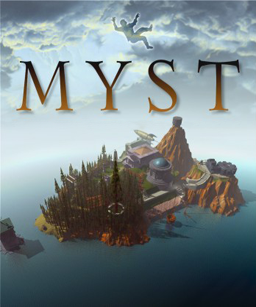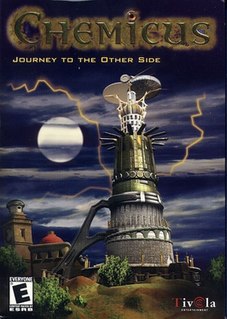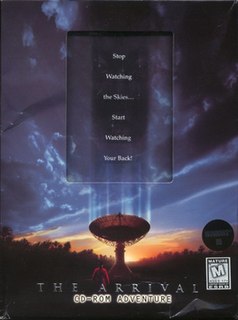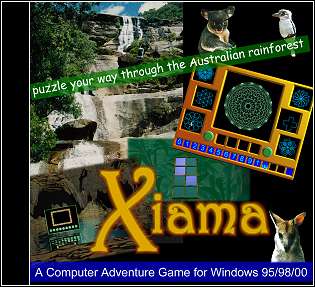
Sid Meier's Alpha Centauri is a 4X video game, considered a spiritual sequel to the Civilization series. Set in a science fiction depiction of the 22nd century, the game begins as seven competing ideological factions land on the planet Chiron ("Planet") in the Alpha Centauri star system. As the game progresses, Planet's growing sentience becomes a formidable obstacle to the human colonists.

Myst is a graphic adventure puzzle video game designed by the Miller brothers, Robyn and Rand. It was developed by Cyan, Inc., published by Broderbund, and initially released for the Macintosh personal computer platform in 1993. In the game, players travel via a special book to the island of Myst. There, players solve puzzles, and by doing so, travel to four other worlds, known as Ages, which reveal the backstory of the game's characters.

Riven is a puzzle adventure video game. It is the sequel to Myst and second in the Myst series of games. Developed by Cyan Worlds, it was initially published by Red Orb Entertainment, a division of Broderbund. Riven was distributed on five compact discs and released on October 31, 1997, in North America; it was later released on a single DVD-ROM on August 17, 1998, with improved audio and a fourteen-minute "making-of" video. In addition to the PC versions, Riven has been ported to several other platforms.

Uru: Ages Beyond Myst is an adventure video game developed by Cyan Worlds and published by Ubisoft. Released in 2003, the title is the fourth game in the Myst canon. Departing from previous games of the franchise, Uru takes place in the modern era and allows players to customize their onscreen avatars. Players use their avatars to explore the abandoned city of an ancient race known as the D'ni, uncover story clues and solve puzzles.

Myst III: Exile is the third title in the Myst series of graphic adventure puzzle video games. While the preceding games in the series, Myst and Riven, were produced by Cyan Worlds and published by Brøderbund, Exile was developed by Presto Studios and published by Ubi Soft. The game was released on four compact discs for both Mac OS and Microsoft Windows on May 8, 2001; versions for the Xbox and PlayStation 2 were released in late 2002. A single-disc DVD version was later released for Windows and Mac OS.

4X is a subgenre of strategy-based computer and board games, and include both turn-based and real-time strategy titles. The gameplay involves building an empire. Emphasis is placed upon economic and technological development, as well as a range of non-military routes to supremacy.
Myst is a franchise centered on a series of adventure video games. The first game in the series, Myst, was released in 1993 by brothers Rand and Robyn Miller and their video game company Cyan, Inc. The first sequel to Myst, Riven, was released in 1997 and was followed by three more direct sequels: Myst III: Exile in 2001, Myst IV: Revelation in 2004, and Myst V: End of Ages in 2005. A spinoff featuring a multiplayer component, Uru: Ages Beyond Myst, was released in 2003 and followed by two expansion packs.

Albion is a single player role-playing video game developed and published by Blue Byte for MS-DOS in 1995. It was originally released in German, then translated to English for international release. The game features a science fiction setting that incorporates traditional fantasy elements, such as magic. The game was intended to be developed for the Amiga computer, but was developed for DOS instead when Commodore declared bankruptcy.

Amber: Journeys Beyond is an American computer game released in 1996 for Apple Macintosh computers and Windows 95. It is the only game produced by Hue Forest Entertainment, founded by Frank and Susan Wimmer.

Nightfall is an American computer game released in 1998 by Altor Systems, Inc. Although claimed to be the first real-time 3D first person adventure game, there are earlier examples of 3D first person adventure games, however, such as Total Eclipse, released in 1988. It employs a three dimensional world and sprites for objects such as vases and rats, as well as true 3D objects such as blocks and statues. Essentially, the gameplay is a combination of 3D first-person shooters such as Doom, the gameplay found in Myst, with some additional elements.

Timelapse is a 1996 graphic adventure game developed and published by GTE Entertainment. Inspired by the game Myst, it tasks the player with the rescue of an archaeologist trapped in another dimension. The player navigates a series of time portals to locations such as ancient Egypt, Maya and the prehistoric Puebloan civilization, while solving puzzles and searching for clues to the archaeologist's whereabouts.

The Myst series of adventure computer games deals with the events following the player's discovery of a mysterious book describing an island known as Myst. The book is no ordinary volume; it is a linking book, which serves as a portal to the world it describes. The player is transported to Myst Island and must unravel the world's puzzles in order to return home. Myst was a commercial and critical success upon release and spawned four sequels—Riven, Exile, Revelation and End of Ages— as well as several spinoffs and adaptations.

The Secret of the Nautilus is a 2002 adventure video game, inspired by Jules Verne's science fiction novel Twenty Thousand Leagues Under the Sea. It was developed by Cryo Interactive and released for Microsoft Windows based PCs.

Ark of Time is a 1997 adventure video game by Italian studio Trecision. Originally created and distributed across Europe, it was later published by Koei Corporation and developed by Trecision S.p.A.

Chemicus: Journey to the Other Side is a 2001 educational adventure video game by Heureka-Klett as part of Tivola's "Quest for Knowledge" series. A sequel named Chemicus II: Die versunkene Stadt was released in 2002. The game was originally released in Germany.

The Lords of Tantrazz is a 1996 adventure video game published by Atlantean Interactive Games.

The Arrival is a 1997 adventure game developed by Enteraktion and published by Live Interactive. It was released on Mac and Windows. It's an adaption of the film of the same name.

Xiama is a 2000 puzzle adventure game by Townsville-based Australian studio Mulawa Dreaming, released on Windows. The game was self-published by its developer, Peter Hewitt, off his website and at a stall in Townville's "Cotter's Markets".
Magnetic: The Game of Games is a 2003 video game developed by Australian studio Mulawa Dreaming. It was the second game by the studio after Xiama. The game had a players only forum on its web site. Magnetic Revisited was a redesigned and rewritten version released in 2010. The game would be followed by Magicama, and Cooroora.

Secrets of the Luxor is a 1996 adventure video game developed by American studio Mojave and published by Ubi Soft for Macintosh, Windows, and Windows 3.x.



















